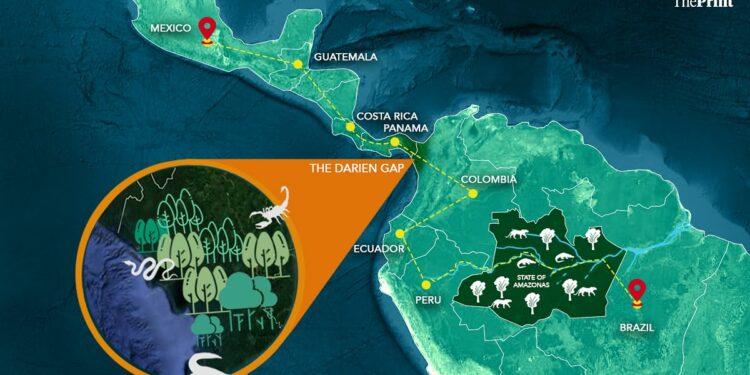“We just had to reach America and on crossing every country, we felt close to America, which was giving us strength to move forward,” said Robin Handa, a resident of Ismailabad, Kurukshetra, who undertook the long and harrowing journey in the hope of a new life in the US.
The manner in which the Indians were deported as part of US President Donald Trump’s crackdown on illegal immigrants has sparked a parliamentary debate.
External Affairs Minister S. Jaishankar said New Delhi is engaging with Washington to ensure that Indian deportees from the US are not mistreated in any manner when they are returned to the country.
But for the 104 Indians on the military flight that landed on 5 February, the assurance was of little comfort.
The deportees—mostly from Punjab, Haryana and Gujarat—are haunted by memories of their harrowing journey: They recall walking for hours on desolate roads, boarding ships to cross seas and often surviving for days in dense jungles with just wild fruit for food.
ThePrint takes you through some of the most gruelling “donkey routes” these deportees endured, only to be sent back, chained and humiliated.
Also Read: Panama to Punjab: Deported Indians recall price they paid to enter US through ‘dunki route’
Brazil to Peru
When Robin Handa took a flight from Mumbai in July last year, he had no idea what lay in store.
The agents who arranged his passage first made him land in Guyana, a small country on South America’s North Atlantic coast, known for its dense rainforest.
From there, he travelled about 1,600 km by road to Brazil where he stayed for about a month before the next leg of his journey began.
From Brazil, he did another 8,000 km, a journey that took him through half a dozen countries—from Peru, Ecuador, Costa Rica, Guatemala and Nicaragua to Mexico—before he reached the California border.
Handa said it was a long and lonely journey, but he developed the ability to fight adverse circumstances along the way.
“Many weeks would pass without talking to my family. I had never been away from my family for so long,” Handa said.
The journey involves crossing multiple Central American countries before reaching Mexico, from where illegal immigrants attempt to cross the US border into California | Credit: Manali Ghosh & Shruti Naithani
Illegal migrants often take this route between Brazil and Peru which takes them through the dense Amazon forest and along the Amazon river, which connects the cities of Manaus in Brazil and Puerto Maldonado in Peru.
According to a media report, the jungle is becoming a key corridor for migrants from Asia and Africa, with their numbers surging over the past few years.
Handa says he and his 30 companions took more than three days to cross the forest. This included travelling for about 63 hours to cross the Amazon River—45 hours on a ship and then another 18 hours in a small boat.
“We were travelling on an empty stomach. There was nothing to eat. We had to stop in the middle of the forest at night where dangerous animals also live, and on the way, we saw many skeletons, which left us even more terrified,” he said.
“I had never seen such dense forests, nor had I ever travelled so much in a boat. Everyone was sitting scared and our eyes were alert.”
He added that the agents didn’t allow them to rest if they got tired while crossing the forest. They threatened to leave them and move ahead.
Going through Peru
After crossing the dense Amazon jungle into Peru, the journey for illegal migrants continues toward Ecuador—often crammed into buses or tightly packed local taxis for hours at a time.
In the last few years, Peru—a country in South America that’s home to a section of the Amazon rainforest—has been facing a growing illegal migrant problem.
According to a media report, 60 percent of foreigners living in Peru have entered or stayed in the country without proper documents.
Agents change with every border crossing. Handa says the agents behaved well on the way only when people gave them money. Sometimes, even after paying the agents, the police took money from all the buses carrying migrants.
“Till I reached Peru, I had $550. The police snatched it all and beat me up when I refused. We thought that the journey would be difficult only till the jungles, but even after that our troubles were not ending,” said Handa.
He added that police extorted $2,000-$3,000 from their bus alone.
“They had guns and if someone refused to give money, they scared them with a gun,” said Handa.
Also Read: A hunt for dunki agents in Punjab, Haryana is on. FIRs, raids, demand for lost money
Mexico: Empty pockets, mafias
From Peru, migrants are taken via Guatemala, Nicaragua and the jungles of Panama, to the Mexican border.
When 18-year-old Khushpreet Singh of Chammu Kalan village of Kurukshetra reached Hermosillo in Mexico, the dream of America was just 1,000 km away.
Hermosillo, formerly called Pitic, is a city in the northwestern Mexican state of Sonora, a key transit point for illegal migrants to reach the Mexico-US border.
Most migrants are empty-handed by the time they reach Mexico, having been robbed of everything—from money to mobile phones.
But the ordeal continues.
When Khushpreet Singh reached Hermosillo from Nicaragua, he was caught by the local mafia and held in a camp for several days.
Singh said that these mafias are connected through agents who lock people in small camps to extort money.
“We were made to clean bathrooms and given electric shocks in the camps,” said Singh. “The mafia people snatched $1,000 from me and gave me electric shocks.”
Panama jungles
For many, the ordeal in Mexico came after an even more harrowing journey.
After 37-year-old Daler Singh reached Brazil via Dubai, he repeatedly called his agent, Satnam, pleading for help to reach the US. But Satnam’s response shocked him. He said there was no option but to take what smugglers called the “donkey route”.
“I reminded him that he had promised to secure a legal way for me to reach the US,” Singh said. “But the agent responded by saying that if I didn’t want to take the donkey route, I should return to Punjab.”
A visibly shaken Singh rubbed his hands nervously as he sat on his cot in Amritsar’s Salempura village, recalling the moment he realised he had no other choice. He had already paid Satnam Rs 30 lakh.
That’s when he decided to risk everything and take the donkey route.
What followed was life-threatening.
Singh was crammed into a trolley to Colombia and then forced to wade through seawater to reach the Panama jungles.
The journey through the Darien Gap—one of the world’s most dangerous migration routes—involved crossing multiple Central American countries, including Panama, Costa Rica, El Salvador and Guatemala, before reaching Mexico, from where immigrants attempt to cross the US border into California.
The Darien Gap is notorious for its steep mountains, dense rainforests, unpredictable terrain and deadly flash floods.
For Singh, having survived the Panama jungles was nothing short of a miracle.
But what he saw would haunt him forever.
For three days, Daler and his group trekked through the dense jungle, struggling to keep up with their Spanish “donkey guide”.
Daler recalls how the guide would beat them if they didn’t walk fast enough or failed to follow.
“If you didn’t follow the guide, you were lost. And the jungle was so dense that it was difficult to find your way,” Daler said.
With no food, Daler survived on wild fruits and drank water from running streams. At night, he slept beneath the trees, as the tents were too small to accommodate all the 30 people he was traveling with.
Along the way, he saw half-eaten bodies, skeletons stripped clean by wild animals. Some had died from heart attacks, others from snake bites. They were simply left behind—nameless, forgotten.
Like Daler, they had been chasing the Great American Dream.
“I couldn’t sleep for days after that,” he said. “Even now, back in Punjab, when I try to sleep, the memories come rushing back. It was heart-wrenching. And there was no internet,” he said, holding his head in his hands as if trying to push the memories away.
Also Read: I risked everything for America—confinement, torture: Robin Handa returns to Haryana
Costa Rica to Guatemala to Mexico
As Daler crossed the Panama jungles, he heaved a sigh of relief. But the respite from danger did not last long.
Mafia gangs, who prey on people along the illegal immigrant trail, soon found him.
With a gun pointed at him, they looted everything—his phone, a small bag of clothes, and the few hundred dollars he had.
The next week was a relentless struggle—walking for hours on foot or, if lucky, crammed into a trolley. Wearing the same shirt and trousers, exhausted and in tears, they pushed forward, forced to jump fences and evade capture. He kept calling his agent, Satnam, telling him about the gruesome journey.
“Satnam would tell these donkey route guides and they would beat me up. After a point, I stopped calling the agent fearing that torture by the guide,” said Daler.
There was nothing to eat. If they were fortunate, they got a handful of rice mixed with water. Otherwise, they survived on the few chocolates Daler had managed to save for himself. But what kept him going was the hope of reaching the US.
Mexico to the California border—and then back where they started
When Daler finally reached the Mexico-California border, he cried tears of joy. It was the moment he had dreamt of for months.
But his dream was shattered instantly.
Just as he thought his nightmare was finally over, he was arrested by the border police.
The border police took him to a detention camp where thousands of immigrants from India, Pakistan and Bangladesh were held.
It was the end of December last year. What followed next were 30 days of sheer misery living in a cramped camp with no space to breathe, stretch legs or even sleep properly.
“The border police had given us aluminium to sleep on and cover ourselves. They were psychologically torturing us by lowering the AC temperature, so much so that the barrack started freezing and we were shivering in the cold,” recalls Daler.
For days, they survived on packets of chips, chocolates, and, if lucky, a can of juice.
“We never got proper food. They only gave us snacks—just enough to keep us alive,” Daler recalled.
Then, on the morning of 2 February, a US official arrived with an announcement: they were going to be released.
Daler felt a flicker of hope. Finally, freedom. But instead of release, he was handcuffed, his feet shackled in chains.
“We were put on a bus and then taken to a massive military aircraft. I thought they were moving us to another camp to sign deportation papers before letting us go,” he said.
But as the plane kept flying for over 10 hours, reality hit him. They were being deported.
To where? He had no idea.
It wasn’t until the flight landed and he saw the airport’s name that the truth sank in.
“I looked out and saw Amritsar. I broke down. After everything—the gruelling journey, the life-threatening risks, and the lakhs I had spent—I was back in India.”
(Edited by Sugita Katyal)
Also Read: UK-Brazil-Colombia-Panama-Costa Rica-Mexico-California—route a deported Indian took to reach US
Source link : http://www.bing.com/news/apiclick.aspx?ref=FexRss&aid=&tid=67adfbf656964238bb545975f827bd92&url=https%3A%2F%2Ftheprint.in%2Findia%2Fpanamas-jungles-nicaraguas-electric-shock-camps-tracing-the-deadly-dunki-route-to-america%2F2490505%2F&c=8369433779235442957&mkt=en-us
Author :
Publish date : 2025-02-12 18:44:00
Copyright for syndicated content belongs to the linked Source.






